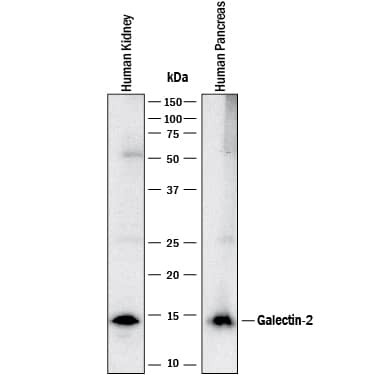Human Galectin-2 Antibody
R&D Systems, part of Bio-Techne | Catalog # MAB1153


Key Product Details
Species Reactivity
Applications
Label
Antibody Source
Product Specifications
Immunogen
Met1-Glu132
Accession # P05162
Specificity
Clonality
Host
Isotype
Scientific Data Images for Human Galectin-2 Antibody
Detection of Human Galectin‑2 by Western Blot.
Western blot shows lysates of human kidney tissue and human pancreas tissue. PVDF membrane was probed with 1 µg/mL of Rabbit Anti-Human Galectin-2 Monoclonal Antibody (Catalog # MAB1153) followed by HRP-conjugated Anti-Rabbit IgG Secondary Antibody (Catalog # HAF008). A specific band was detected for Galectin-2 at approximately 14 kDa (as indicated). This experiment was conducted under reducing conditions and using Immunoblot Buffer Group 1.Detection of Galectin-2 in Human HepG2 cells by Flow Cytometry.
HepG2 human hepatocarcinoma cell line was stained with Rabbit Anti-Human Galectin-2 Monoclonal Antibody (Catalog # MAB71153, filled histogram) or Rabbit IgG control antibody (Catalog # MAB1050, open histogram) followed by APC-conjugated Anti-Rabbit IgG Secondary Antibody (Catalog # F0111). To facilitate intracellular staining, cells were fixed and permeabilized with FlowX FoxP3 Fixation & Permeabilization Buffer Kit (Catalog # FC012). View our protocol for Staining Membrane-associated Proteins.Applications for Human Galectin-2 Antibody
CyTOF-ready
Intracellular Staining by Flow Cytometry
Sample: HepG2 human hepatocarcinoma cell line fixed and permeabilized with FlowX FoxP3 Fixation & Permeabilization Buffer Kit (Catalog # FC012)
Western Blot
Sample: Human kidney tissue and Human pancreas tissue
Formulation, Preparation, and Storage
Purification
Reconstitution
Formulation
Shipping
Stability & Storage
- 12 months from date of receipt, -20 to -70 °C as supplied.
- 1 month, 2 to 8 °C under sterile conditions after reconstitution.
- 6 months, -20 to -70 °C under sterile conditions after reconstitution.
Background: Galectin-2
The galectins constitute a large family of carbohydrate-binding proteins with specificity for N‑acetyl-lactosamine-containing glycoproteins. At least 14 mammalian galectins, which share structural similarities in their carbohydrate recognition domains (CRD), have been identified to date. The galectins have been classified into the prototype galectins (-1, -2, -5, -7, -10, -11, -13, -14), which contain one CRD and exist either as a monomer or a noncovalent homodimer; the chimera galectins (galectin-3) containing one CRD linked to a nonlectin domain; and the tandem-repeat galectins (-4, -6, -8, -9, -12) consisting of two CRDs joined by a linker peptide. Galectins lack a classical signal peptide and can be localized to the cytosolic compartments where they have intracellular functions. However, via one or more as yet unidentified non-classical secretory pathways, galectins can also be secreted to function extracellularly. Individual members of the galectin family have different tissue distribution profiles and exhibit subtle differences in their carbohydrate-binding specificities. Each family member may preferentially bind to a unique subset of cell-surface glycoproteins (1-4).
Galectin-2 is a monomeric or homodimeric prototype galectin that is expressed in hepatoma, stomach epithelial cells and in colorectal and neural tumors. The functions of Galectin-2 has not been reported. Human and mouse Galectin-2 share approximately 65% amino acid sequence similarity (1-4).
References
- Rabinovich, A. et al. (2002) Trends in Immunol. 23:313.
- Rabinovich, A. et al. (2002) J. Leukocyte Biology 71:741.
- Hughes, R.C. (2001) Biochimie 83:667.
- R&D Systems Cytokine Bulletin, Summer, 2002.
Alternate Names
Gene Symbol
UniProt
Additional Galectin-2 Products
Product Documents for Human Galectin-2 Antibody
Product Specific Notices for Human Galectin-2 Antibody
For research use only
